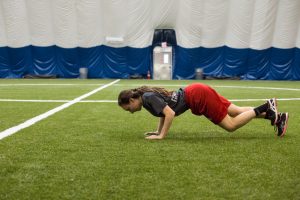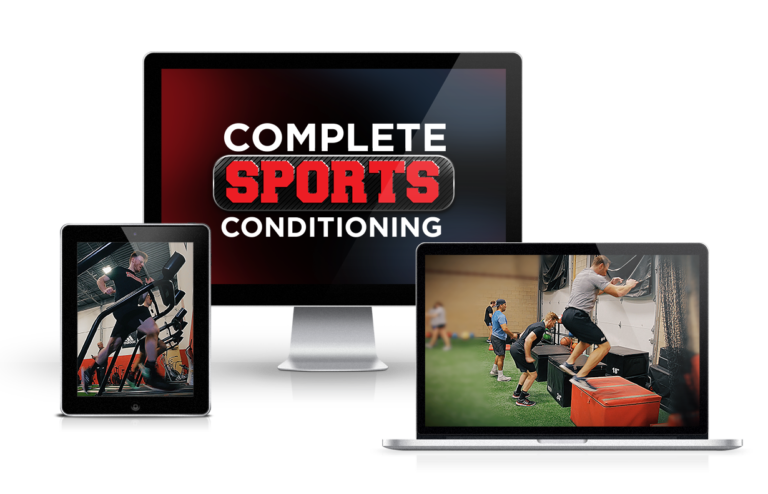Speed Training for Acceleration
By: Patrick Beith
Speed is a product of stride length (the distance your hips travel in a stride) and stride frequency (the number of steps you take in a given time period). However, you will not reach top speed by focusing on increasingly larger steps to increase stride length or taking short, quick steps to increase stride frequency. Instead, top speeds are created by applying ‘optimal’ force to the ground. Both length and frequency are improved by strength so better strength application results in faster speeds. Really, acceleration training is a form of strength training.
Ground contact times (the amount of time each foot spends on the ground) are another important factor to consider during acceleration. During the earliest parts of acceleration, especially the first two steps, you are trying to overcome (inertia) the weight of your body by moving it forward as quickly as possible. This takes a great deal of strength and power. The stronger and more efficient you are, the more you can extend your acceleration phase.
Since high intensity sprint work involves recruiting specific groups of muscle fibers improves the efficiency of neuromuscular firing patterns, sprinting is taxing to the central nervous system. Once the CNS becomes fatigued, workouts quickly lose their effectiveness. Any type of speed work must be done with full recovery. Generally speaking, that means approximately one minute of rest for every 10 yards that you run. Sprinting is a highly technical activity. Without full recovery, both your muscles and your central nervous system will begin to fatigue quickly, reducing the short and long term effectiveness of your training. For this reason, acceleration should not be trained with fatigue present. To optimize your success, full recovery must be adhered to both in your individual workouts as well as your weekly plan. It takes roughly 36-48 hours to fully recover from a speed workout.
Acceleration Cues
Drive the lead arm (same as front leg) up as you begin to sprint.
Drive out so the body is at a 45 degree angle to the ground.
Keep the heel recovery low during the first 6-8 strides.
Drive the elbows down and back. Keep the hands loose, but not open. Arms should remain at approximately 90 degrees from the elbow.
Step over the opposite knee and drive the foot down into the ground to create maximal force.
Don’t force yourself to ‘stay low’. This will limit the amount of force you can apply to the ground and leads to poor acceleration. Let your upper body unfold naturally. ‘Staying low’ will occur naturally if you are already strong enough.
Get Vertical!
At the beginning of your speed training season, acceleration work is used. You can’t be efficient running longer distances without getting the proper strength levels and neuromuscular efficiency of the shorter intervals. As your athletes get stronger, you can extend out the acceleration distances. You want your athletes to be driving out as far as possible. The stronger the athlete is the further the acceleration phase will be and will set-up the athletes’ top speed better later on.
During acceleration, the foot should strike directly below or slightly behind the hips. You must be able to drive out so your body is at a 45 degree angle to the ground and step over the opposite knee and drive the foot down into the ground to create maximal force.
Horizontal to Vertical
Some athletes aren’t strong enough to hold and maintain that ideal drive phase. So, you must trick the athlete’s body and make it so that they have to get into the right position.
Start your acceleration work on the ground and work your way up. In order to put the athletes in the best mechanical position, even without great strength levels, athletes will start with short intervals, in a horizontal position. As the athletes get stronger, the acceleration intervals are lengthened and/or the starting positions are more vertical.
Sample beginning of the season acceleration workout:
4 X 25 yards each (400 yards total)
2.5 minute rest between each rep/4 minutes between each exercise
a) Push-up ‘Down’
b) Push-up ‘Up’
c) Seated Start-Backwards
d) Seated Start-Forward
As the athlete shows that they can handle these positions and their form doesn’t break down at all during the 25 yards, you can start lengthening the interval distance and/or change the starting positions.
Maximum Velocity
Maximum Velocity is another way of saying running at full speed. The point in a race, workout or game that you reach maximum velocity depends on strength levels, experience and running mechanics. However, regardless of where and when you reach full speed, there are some differences in running mechanics and effort when compared to acceleration.
When running at full speed, you no longer need to try and apply the same level of force to the track as during acceleration. This is a common mistake among inexperienced athletes. Now that you are at full speed, you will be completely upright (perpendicular to the ground) and your body will no longer be leaning at an angle as you were during acceleration. By continuing to try to run faster and faster throughout a run, as though you were still accelerating, you are actually going to have a breakdown in running mechanics. By continuing to try to accelerate while beginning to fatigue, you will only slow yourself down faster because you can not continue to coordinate your movements with accuracy.
Instead, you want to relax or ‘float’ during maximum velocity. What this means is that you want to ease back in the amount of effort you are expending while running, but without slowing down and losing any speed. This idea sounds contradictory and like any new skill, it takes some practice to perfect. While running, you want to continue to step over the opposite knee, but instead of driving the ball of the foot down into the ground, you are just going to tap the foot downward, letting the ground come to you. Continue to drive the elbows down and back at the same speed, but without the same intensity as during the early part of your run. Remember, you are not going to get any faster at this point so energy conservation is important. We know that your brain tells you to keep running harder so that you do not slow down, but you have to fight the urge to do that and run smart. It is the ability to make these types of adjustments that can be the difference in running a fast time, outrunning an opponent or chasing one down to make the play.
Maximum Velocity Cues
Continue to step over the opposite knee, but let the ground come to you.
FLOAT – Ease back in intensity, but don’t slow down.
Fight the urge to continue to run faster and harder. One of the goals of top speed training is to learn how to decelerate the slowest. The athlete who decelerates the slowest runs the fastest. Relaxation is the only way to decrease the speed at which you slow down.
Sample Workouts:
1. Fly 20s, 30s and 40s:
Place a cone at the starting line, at 15y, at 35y and at 55y. Accelerate hard to the first cone (15y). Maintain the speed you have generated by running relaxed and following the maximum velocity cues from 15 – 35y. Once you hit 35y, slowly decelerate for the next 20y coming to a full stop at the last cone. This is a fly 20. Once you are comfortable holding that speed for 20y, you can move the second cone to 45y (fly 30s) and 55y (fly 40s). Total volume for these workouts should be between 250 – 350 yards.
2. Sprint/Float/Sprint
Place a cone at the starting line, 15y, 25y, 35y, 45y and at 65y. Accelerate hard to the first cone (15y). Maintain a hard sprint for 10y, focusing on maintaining the speed and intensity created during acceleration. Once you hit the next cone (25y) go into a float by easing back in intensity (don’t try to continue to get faster) without losing any speed. At the next cone (35y) go back to a hard sprint, running at full intensity and trying to increase your speed. At the next cone (45y), shut down by slowly coming to a stop. You should not be at a complete stop before the final cone at 65y, giving you a full 25 yards to slow down.
Speed Endurance
Speed endurance is the ability to maintain speed in the presence of fatigue without decelerating. Therefore, speed/power athletes must train the ability to maintain high levels of speed, even when tired. As you can imagine, making improvements in this area can have profound effects on success and performance late in competitions when every athlete is tired, but the most critical moves and decisions are made and games are won and lost.
Because speed endurance work is based around the idea of athletes competing in a state of physical fatigue, these workouts also have a useful mental component as well. When athletes get tired, they have a tendency to revert back to what is easy for them, which is usually poor form and technique. Therefore when performing this type of workout, it is important to focus on efficiency and form, even when it feels slower. Make the commitment to perfection in practice so that during competition you can focus solely on competing and performing your best. By improving the ability to stay mentally focused on a physically demanding and exhausting workout, athletes improve their ability to execute during the most important moments of their game or competition.
Primarily we use two types of workout to develop speed endurance:
Short distance, short rest: Run for a short distance (10 – 35 yards) while only getting a short rest period (10 – 30 seconds) between repetitions.
Example:
2 sets of 7 x 25 yards with 25 seconds rest between reps and 3 minutes between sets
Longer Distance, Longer Rest: Run a longer distance (8 – 20 seconds, or 60 – 150 yards) at full or near full intensity (90% – 100%) with full or near full recovery (5 – 15 minutes) between each repetition.
Example:
3 x 80y at full speed with 7 minutes rest between each repetition
2 x 120y @ 90% with 10 minutes rest between each repetition
The type of workout that will reap the greatest benefits depends on the demands of the sport that the athletes compete in and can be modified, adjusted or adapted to suit those particular needs. For some sports, such as football, soccer, field hockey and lacrosse, where the majority of the demand of the sport consists of short bursts of acceleration followed by low intensity movements, the greatest benefits may be from running workouts of short duration with short recoveries. On the other hand, athletes competing in sports requiring continuous high intensity runs, such as track and field sprinters, may find greater benefit in runs of longer distance and greater recovery times. Both types of workouts allow athletes to compete longer into their competitions without showing high degrees of fatigue, increasing the likelihood of success.
By integrating all the training modalities, concepts, exercises, drills and workouts presented in the Complete Speed Training System you have begun the rapid transformation toward maximizing your speed potential, and therefore a whole new level of athletic success. Continue to work hard, train smart and you will stay A Step Ahead ™ of the competition.
About the Author:
 Patrick Beith is the Owner and Founder of Athletes’ Acceleration, Inc. Patrick holds his Bachelor of Science in Exercise Physiology. He is recognized by National Strength & Conditioning Association (CSCS), National Academy of Sports Medicine (PES), American College of Sports Medicine (HFI), International Youth Conditioning Association (IYCA), as well as USA Track & Field Coaching Level II (Jumps, Sprints, Hurdles and Relays). A renowned coach, Patrick specializes in speed training & athlete development of various levels. As a performance coach, his concepts and products have helped thousands of athletes & coaches around the world. From athletic development to fitness business development – consulting, lecturing and teaching – Patrick strives to help each client achieve their goal and to reach their full potential. To learn more about Coach Beith click here.
Patrick Beith is the Owner and Founder of Athletes’ Acceleration, Inc. Patrick holds his Bachelor of Science in Exercise Physiology. He is recognized by National Strength & Conditioning Association (CSCS), National Academy of Sports Medicine (PES), American College of Sports Medicine (HFI), International Youth Conditioning Association (IYCA), as well as USA Track & Field Coaching Level II (Jumps, Sprints, Hurdles and Relays). A renowned coach, Patrick specializes in speed training & athlete development of various levels. As a performance coach, his concepts and products have helped thousands of athletes & coaches around the world. From athletic development to fitness business development – consulting, lecturing and teaching – Patrick strives to help each client achieve their goal and to reach their full potential. To learn more about Coach Beith click here.
Recommended Athletes Acceleration Products








0 Comments for “Speed Training for Acceleration”